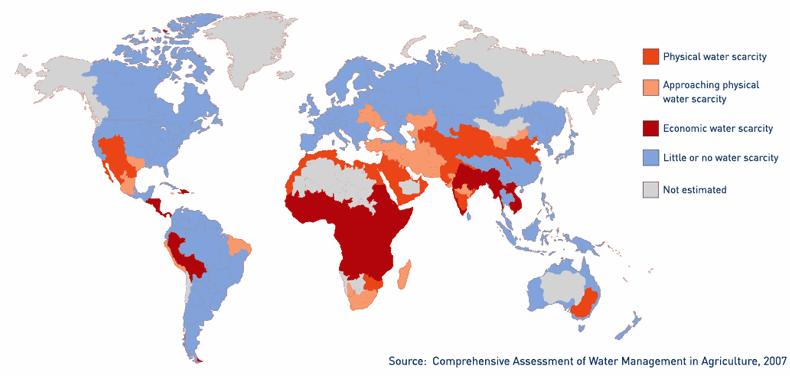In a new study conducted by the Oak Ridge National Laboratory to be published in the journal Computers & Geosciences, in May 2012, , researchers announced a new method for assessing global water stress. The tool they developed integrates climate, population and freshwater statistics to provide future projections. The authors, Esther Parish, Evan Koda, Karsten Steinhaeuser and Auroop Ganguly are the first to integrate disparate observations to create a global picture of areas potentially vulnerable to water shortages.
Water stress is defined as availability of freshwater per capita of less than 1.7 million liters (450,000 gallons) per person per year. That seems like a lot of freshwater, 4,657 liters (1,232 gallons) per person per day. But the number represents much more than water for domestic usage such as drinking, washing and sanitation. It includes water used for industrial and agricultural purposes.

The team used high-resolution Global LandScan population distribution datasets, combined these with population projections from the Intergovernmental Panel on Climate Change (IPCC) the Community Climate System Model 3, and current freshwater supply to come up with projections estimating demand for freshwater by 2025, 2050 and 2100. Interestingly, the variable that most impacts the data modeling is not rising temperatures from global warming, but rising human global population.
Results from the study show that in North America, Florida and the American Southwest are most vulnerable to water stress in the near and longer term. The Great Lakes region on the other hand should be sustainable.
On a global scale the data concludes that by 2100, 56 to 75% of the world’s population will experience freshwater stress. Central and South America may experience massive population shifts based on projected water scarcity data.

















Great post. One could think that places like the American South, where temperatures are highest, would be the places where water efficiency measures are not only most greatly demanded but most greatly utilized. Reality seems to (strangely) prove otherwise. Water efficiency is key to reining in our blatant disregard of one of our most valuable resources. When it comes to America, the vast majority of water use goes to farming and power production. This is where we should be focusing on innovative solutions.